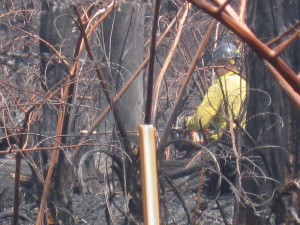 Media release | Hawaii Volcanoes National Park
Media release | Hawaii Volcanoes National Park
Fire Overview: Napau Fire Start Date – March 5, 2011, / (Lat/Lon: 19⁰ 22’29” x 155⁰ 7’ 25”; el. 2450). The fire remained active today due strong gusty trade winds. Flames were visible along the south flank and Chain of Craters Road. Due to smoke impairing driver visibility, the road was closed and visitors were escorted out the fire area by park rangers and firefighters. Helicopter bucket drops were utilized to cool hotspots and slow the fire’s forward progress. Helicopter operations were shuttling crews and equipment into the fire area to begin mop-up of hot spots. Approximately 2,000 acres have burned, and there is no estimated containment date. The Napau Fire is approximately seven miles southeast of the Kilauea Visitor Center, located on the east rift of Kilauea Volcano. It is a lava caused wildfire resulting from the March 5, 2011, Kamoamoa Fissure Eruption.
Strategy: The Horseshoe Meadow Hotshots, a highly skilled interagency fire crew from the Sequoia National Forest, in California, arrived today. All fire resources are now in place to put out the Napau Fire. For safety and to reduce multiple firefighter helicopter shuttle flights in to the fire area, fire managers are considering camping (spiking) fire crews near the fire area. Standing dead trees, snags, continue to pose a high hazard safety issues to firefighters.
Values to be protected: All fires pose significant threats to the ecological health of the park, which are not fire adaptive, and will be put out. A high priority fire protection goal is the east rift Special Ecological Area (SEA), an intact lowland rain forest, which has been intensively managed to exclude invasive species and protect and restore highly valued native plant and animal communities. The north flank has the greatest potential threat to the SEA. Protected over decades by Hawai’i Volcanoes National Park, the rain and mesic forests threatened by the spread of the Napau Fire are home to plants, birds, bugs, spiders, and bats found only in Hawai’i. They include the endangered Hawaiian bat (`ope`ape`a) Hawaiian hawk,(`io) and other uniquely Hawaiian plants and animals such as Hawaiian thrush, (`oma`o), lama and sandalwood trees, happyface spiders, carnivorous caterpillars, and Hawaiian honeycreepers (`apapane and `amakihi). National park and USGS Hawaiian Volcano Observatory (HVO) infrastructures, monitoring equipment, and other visitor features near the fire are also being protected.
Fire Resources: Hawai`i Volcanoes National Park firefighters are being augmented with NPS fire crews from Whiskeytown National Recreation Area, Olympic and Yosemite National Parks (NPS), the Pacific West Regional Office of NPS, National NPS Fire Office in Boise and the USDA Forest Service (Eldorado, Sequoia, Stanislaus and Los Padres National Forests in CA.); nearly 40 firefighters and management staff are committed.
Air and Smoke: Strong trade winds returned today, with gusts up to 40 mph. Periodic rain showers continue and smoke is visible along the Chain of Craters Road. In addition to smoke, air quality is constantly monitored in regards to sulfur dioxide emissions from volcanic activity. Fire managers will continue to coordinate fire efforts with USGS HVO scientists regarding eruption activity and air quality.
Closures: The Chain of Craters Road is closed approximately 6 miles from the visitor center at Mau Loa o Mauna Ulu.
Partners Involved: US Geological Survey Hawaiian Volcano Observatory and USDA Forest Service.

by Big Island Video News6:33 pm
on at
STORY SUMMARY
Media release | Hawaii Volcanoes National Park Fire Overview: Napau Fire Start Date – March 5, 2011, / (Lat/Lon: 19⁰ 22’29” x 155⁰ 7’ 25”; el. 2450). The fire remained active today due strong gusty trade winds. Flames were visible along the south flank and Chain of Craters Road. Due to smoke impairing driver visibility, […]